On the Road is a weekday feature spotlighting reader photo submissions.
From the exotic to the familiar, whether you’re traveling or in your own backyard, we would love to see the world through your eyes.
It’s Albatrossity Monday! Then we have the frosty post that didn’t publish on Wednesday of last week, followed by a 3-part series from UncleEb.
click on the image below for a bigger, non-blurry image)
Albatrossity
Much of the country was hit with major cold temps and snowy weather in mid January, and my patch of Flyover Country was no exception. So I thought I should put together a batch of images from that time, even though some of us (including me) would really rather put that kind of weather in the rear-view mirror. Some of these are common backyard feeder birds, since last week’s series of birds at a feeder in North Carolina seemed to be well-received.
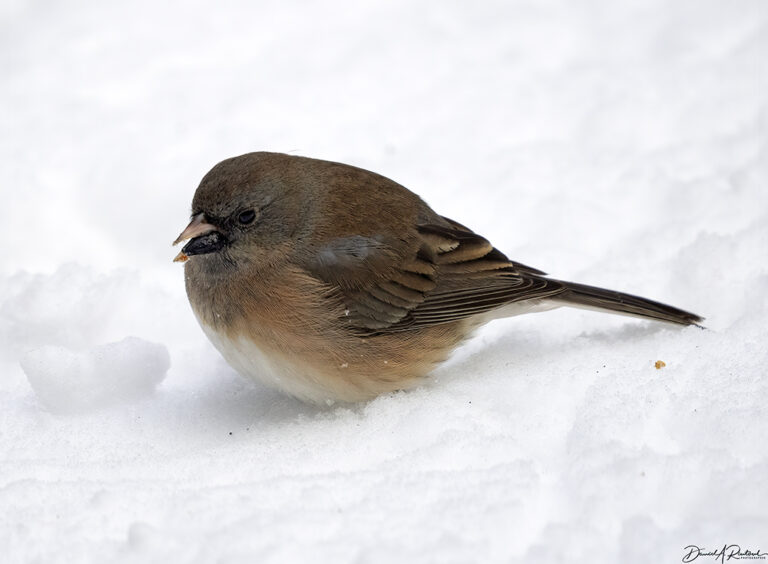
I was not able to get out and about as much as usual after a series of snowstorms dumped 5-8 inches here, and many of the back roads were either unplowed or inadequately plowed. That meant that I spent a lot of time filling the feeders, scattering seeds on the snow-covered deck, and replenishing the water in the birdbath, as well as watching to see what birds took advantage of those resources. A lot of them were Dark-eyed Juncos (Junco hyemalis), who discovered the seeds on the deck quite quickly. As you may know, Dark-eyed Juncos come in a variety of flavors, and we get most of them here in Flyover Country. This is the pink-sided version. Click here to enlarge the image.
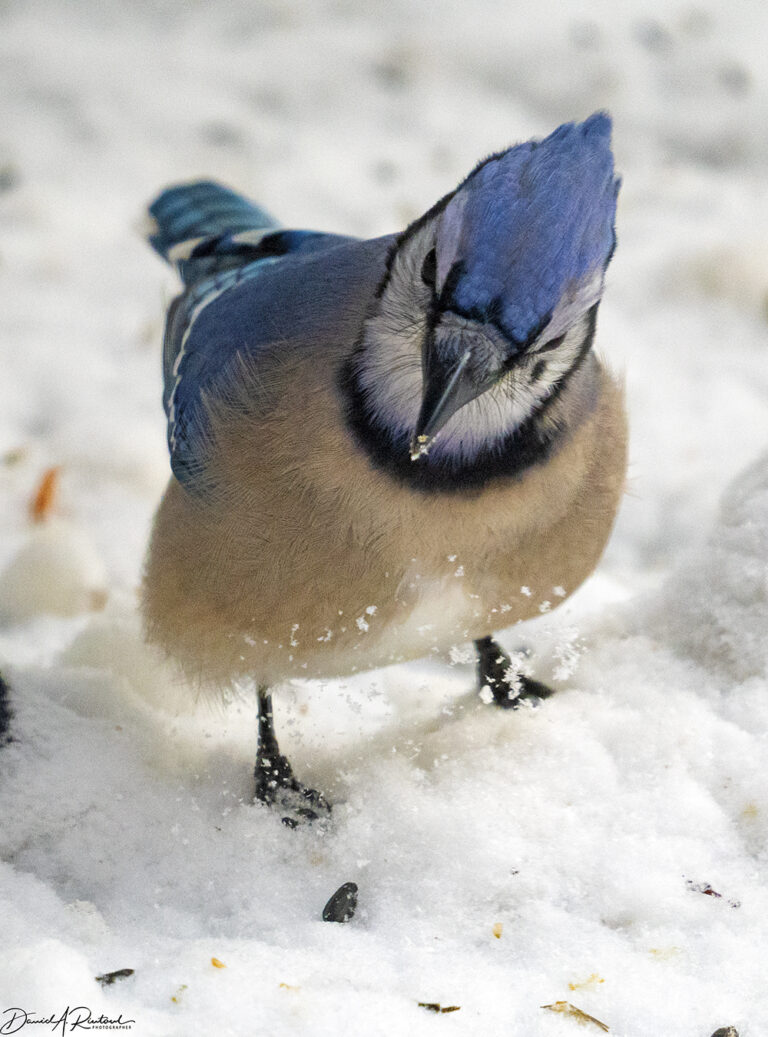
The Blue Jays (Cyanocitta cristata) were also very efficient at clearing up the scattered seed on the snowy deck. Our backyard jays had a good summer, producing at least 5 youngsters, and this might be one of those. But the jay population in the winter here is embiggened by migrants from the north, and this could be one of those, since it has a very thick and dark “necklace” and a relatively dark grayish underside. Click here to enlarge the image.
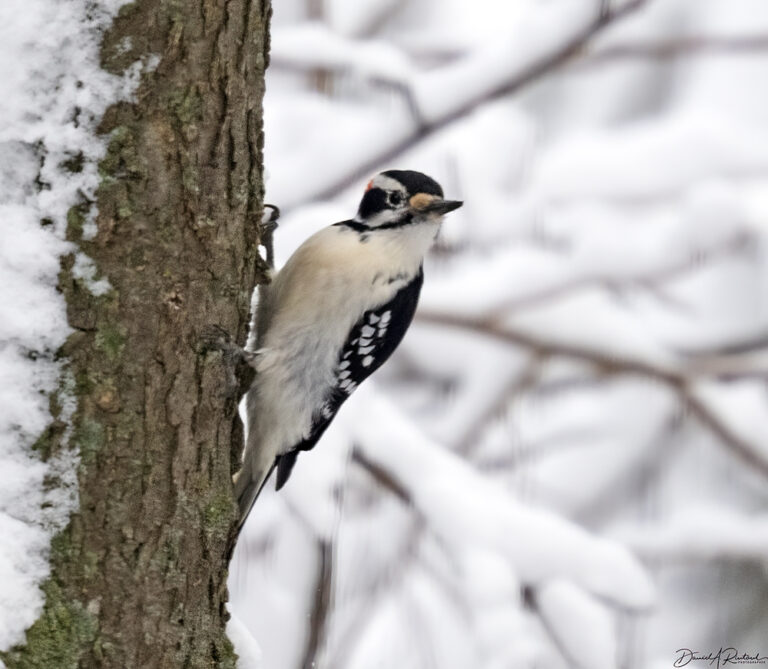
The snow arrived on Monday 1/8, and was thick and wet at first, coating the north sides of the trees white. Since temps hovered mostly around 0° F for ten days after that, it lingered there. The male Hairy Woodpecker (Dryobates villosus), who has a territory and a mate somewhere in the woods behind our house, knew enough to perch on the non-white side of the trees while he was waiting for a chance at the suet feeder. Click here to enlarge the image.
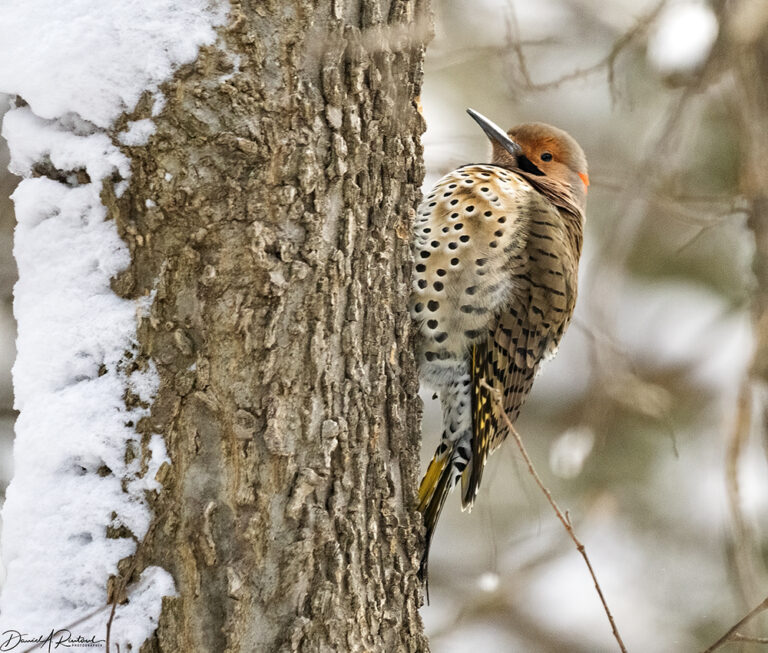
The male Northern (Yellow-shafted) Flicker (Colaptes auratus) followed suit. Click here to enlarge the image.
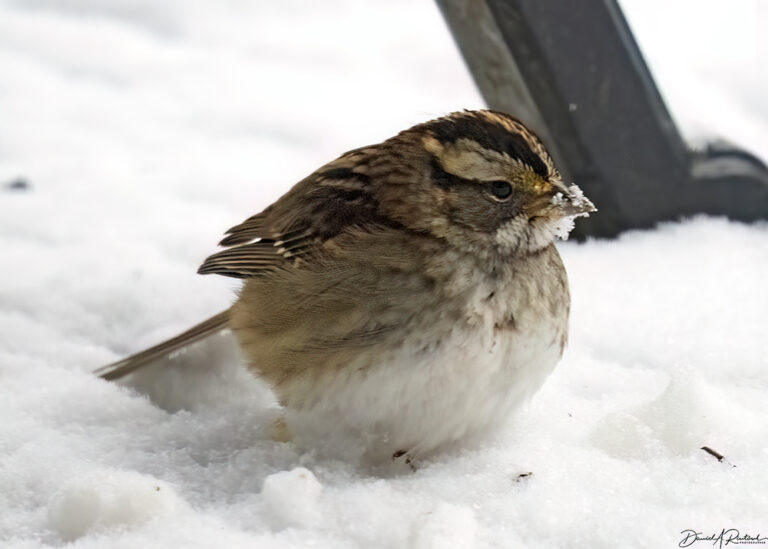
A rare visitor to our yard, although not uncommon in the area in winter, this White-throated Sparrow (Zonotrichia albicollis) was very fluffed up and round. I’d have to say that it does not look happy, but hopefully the extra seed supply helped it through these trying times. Click here to enlarge the image.
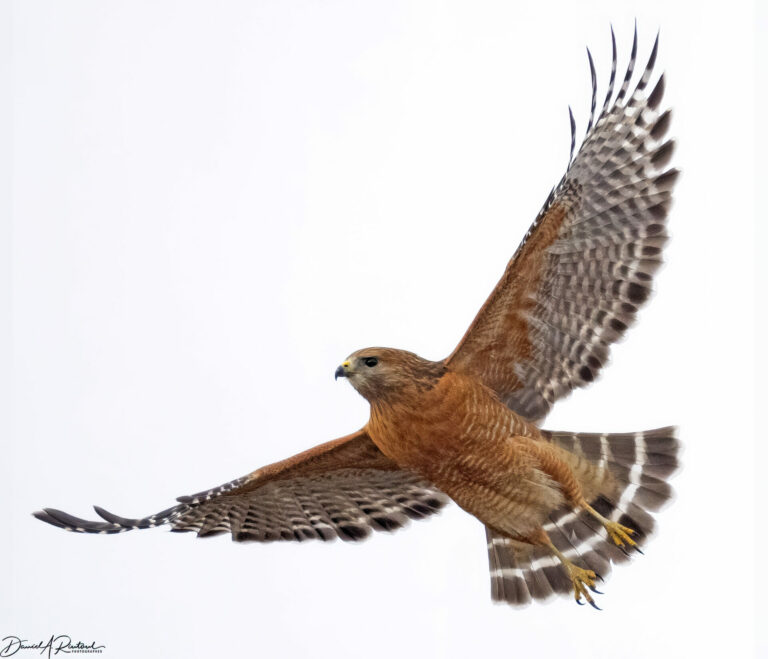
We also have a pair of Red-shouldered Hawks (Buteo lineatus) living in the back woods, but generally they do not spend much time in view of our windows. Their typical foods (lizards, snakes, and small rodents) however, were probably becoming harder to find as the snow cover persisted for many days, so one of the adult birds started watching the feeders, possibly in hopes of snagging one of the seed-eating birds. Click here to enlarge the image.
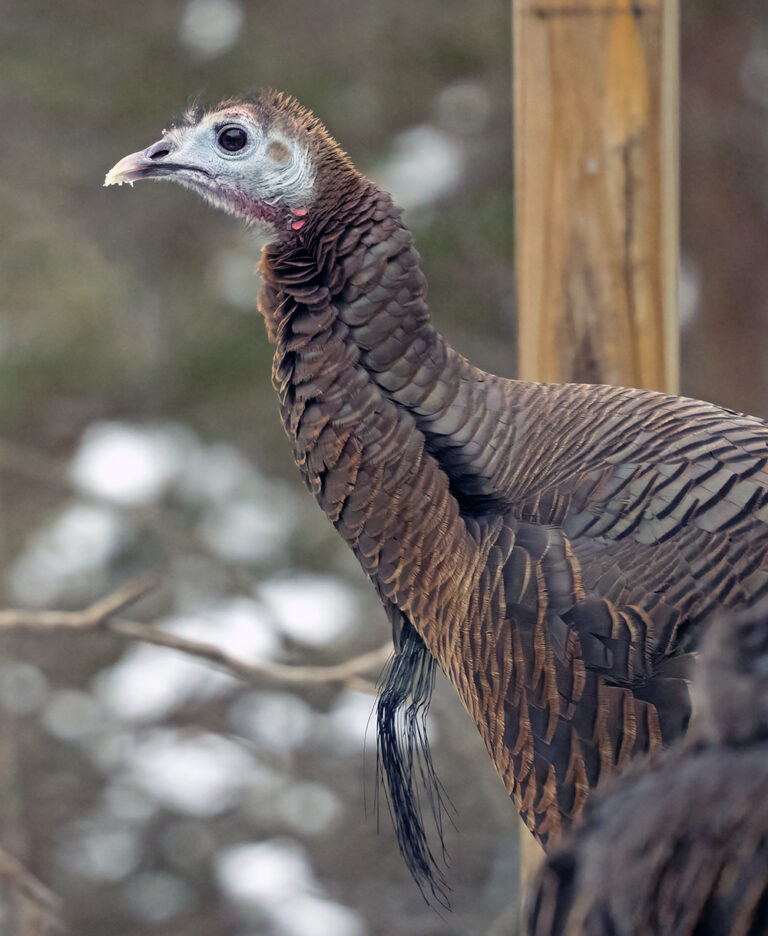
The snow cover probably also was not welcomed by the Wild Turkeys (Meleagris gallopavo) in our neighborhood, so they also would check out our yard for any seed that may have been tossed from the deck by other birds. Some of them are even bold enough to fly up onto the deck and scratch around in the snow for tidbits; this did not amuse the squirrels. This hen has been in the local herd for at least a couple of years, and she is quite recognizable because she has a long “beard”, which is typically a male characteristic. But a bit of research revealed that it is not uncommon in hens; some estimates put the frequency at 5-10%. Click here to enlarge the image.
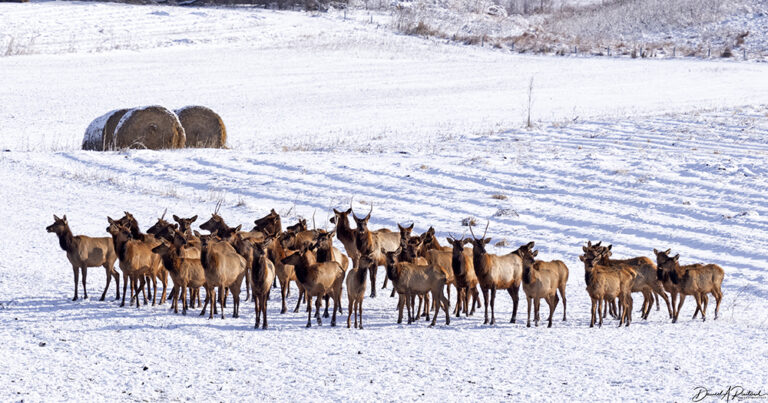
On one of the days that I was able to get out and about, sticking to the mostly plowed paved surfaces, I found this herd of Elk (Cervus canadensis, aka Red Deer in Eurasia). Once an abundant member of the prairie fauna, they were extirpated from the state in the 19th Century. In the 1960s they were reintroduced at a state game refuge, and since then several other reintroduction efforts across the state have been successful. These are almost certainly part of the herd on Ft. Riley, an Army base whose boundary is only a couple of miles from where this picture was taken. They are not fenced in, so they are free to wander, and again, the snow cover probably makes them wander further and look harder for food. Click here to enlarge the image.
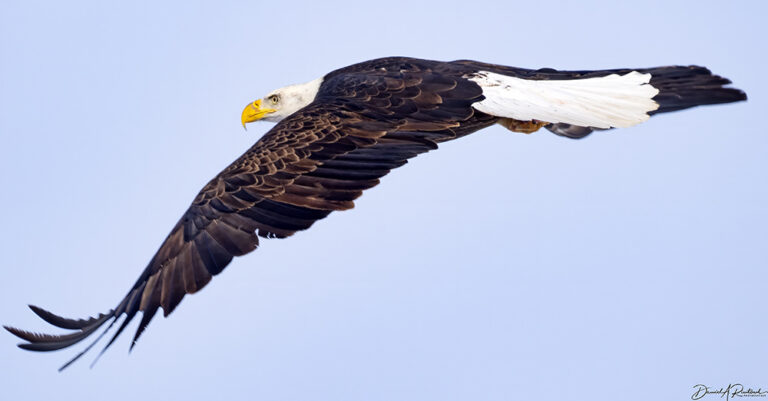
Bald Eagles (Haliaetus leucocephalus) are another successful recovery story in Flyover Country. Once extremely rare and only seen in winter, they are now abundant here year-round. Click here to enlarge the image.
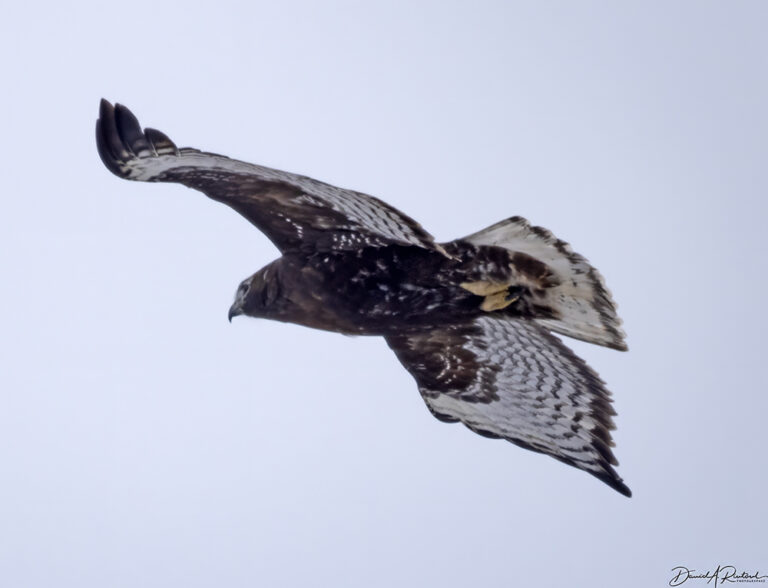
Finally, a winter bird compendium would not be complete without a shot of Harley, the Harlan’s Red-tailed Hawk (Buteo jamaicensis harlani) who has spent at least eleven winters on a territory less than a mile from my house. It’s always good to see him return in the fall, and he was on post before and after our January snow and cold. Click here to enlarge the image.

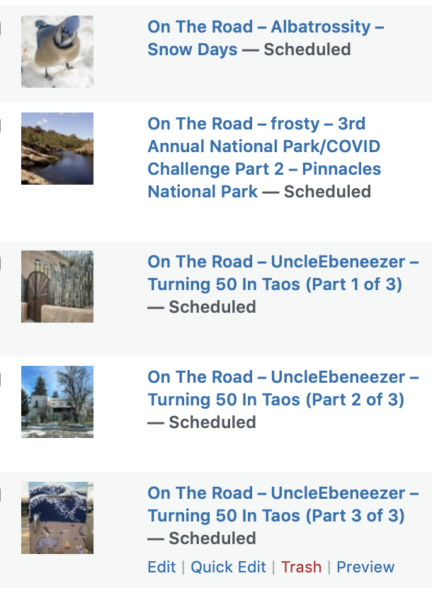
Nelle
My deck is a mess of sunflower hulls as the snow melts. We continue to be inundated by gangs of sparrows, who drive off other birds. Only the juncos stand up to them. It does set the table for hawks from the nearby farm fields, though.
We had two feet of snow, plus, and temps reached -18, with windchill in the -30s. I could only wedge the back door open a little bit, so could barely scatter seed on the deck. At those temps, we had a lot of visitors.
OzarkHillbilly
We had lots of Juncos, Titmice, and chick-a-dee-dees, as well as a few blue jays, Downys and 3 pairs of Cardinals. And 1 Carolina Wren who made my day every time he (I think it was he) showed up. I did see a Northern Filcker once, pretty sure he came more than that.
SteveinPHX
That must be a great feeling when you spot Harley returning in another fall.
Thank you for the photos!
HinTN
@Nelle:
As did we, although our temps were “just” single digits. Lots of cardinals and blue Jays along with the smaller birds. For several of the coldest, most snow covered days we had a herd of grackles. Boy, howdy, did I run through the black oil seed.
eldorado
these are great photos! flickers are one of my favorites
eclare
Yay Harley! Glad to see him back after a rough winter. Your photos really capture each bird’s personality, thank you.
evodevo
great pics! THX. A lot of those species are here in north central KY as well, hanging around my feeder. I have a running battle with the local flickers, however, because they peck holes up under my eaves. I mostly have juncos, titmice, chickadees, a hairy or downy woodpecker or two, a carolina wren who hangs out in our open woodshed and scolds me every time I go to feed the furnace, and nuthatches.
eclare
@Nelle:
I cannot imagine. We got down to -1 in Memphis, which was unimaginable, until it happens. Luckily I never lost power or water, our infrastructure is not built for that.
Trivia Man
Our woodpecker came back yesterday. I believe its a Downey. Every day about 7 am, rat-a-tat on the metal flashing of the chimney. Territory marking I assume. I like it.
frosty
I bought a seed feeder for the snow. The squirrels swarmed it. I went back and bought a squirrel cage. They sit on top of it chewing at the bars, stripping the plastic coating off. They aren’t giving up snd the birds aren’t hanging around.
I’m discouraged.
frosty
@Nelle: So it’s a hawk feeder!!
Miss Bianca
Juncos, chickadees, and woodpeckers appear to be the most frequent feeders at the suet brick that’s our winter birb-watching station.
stinger
Hi, Harley!
Great set of birds today, and love the elks!
I also love my Albatrossity Hawks & Owls calendar — eager for Thursday to arrive so I can flip to Mr. Merlin!
StringOnAStick
On our coldest morning, I opened the curtain by the close feeder (the window is covered in reflecting stickers to warn the birds from hitting the glass), and saw a mourning dove shivering in the space below the feeder, so I really increased the amount of high fat foods out there.
There seem to shifts of birds, starts with mourning doves, pygmy nuthatches, lesser goldfinch mobs, juncos, cassins finch, house finch, sparrows, red shafted flickers, varied thrush, and the occasional downy woodpecker. I do enjoy the daily parade.
The local subreddit had a post excoriating someone who left all the apples on their tree to rot (it was a huge fruit year here), which drew rats, which then drew eagles and now the area is littered with rat parts and the rats are moving into the human structures to escape the eagles. It’s the circle of life!
mrmoshpotato
Great pictures as usual – particularly those hawks and bald eagle in flight.
mvr
Good to see all of those. Our sparrows mostly tend to be house sparrows, though there seems to be enough variety in just how they look that I’m never sure some other sort of sparrow has not snuck in. So the white throated sparrow is something I envy.
We almost never get hawks in our yard, so I envy you twice over.
Thanks!
Albatrossity
@stinger: Thanks! I’m glad you like the calendar, and yeah, that Merlin shot is among my very favorites as well!